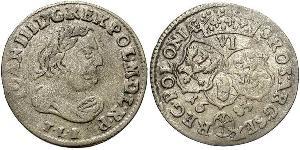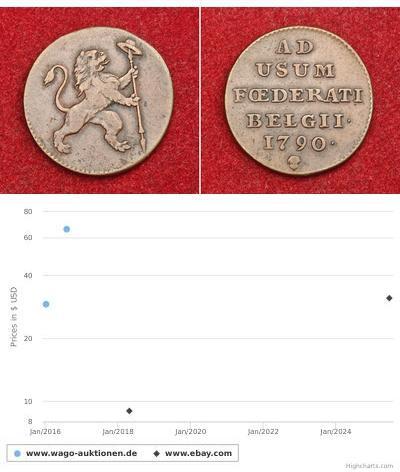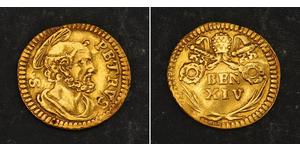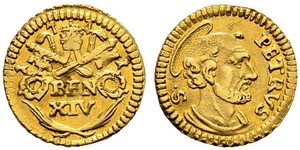6 Grosh Polish-Lithuanian Commonwealth (1569-1795) Silver Sigismu ...
1599, Poland, Sigismund III Vasa. Silver 6 Groszy Coin
Mint Year: 1599
Reference: Kopicki 1246 (R1!).
Denomination: 6 Groszy (Szostak)
Mint Place: Marienburg (Malborg)
Mint Masters: Gonzalo & Gobelius (privy marks: Diamond-Ring / Triangle/Delta)
Weight: ca. 4.5gm
Diameter: 28mm
Material: Silver
Obverse: Draped and crowned (small) bust of Sigismund III Vasa with large collar right.
Legend: . SIGISMVN . III . D : G (shield w. lion) REX . PO . M . D . L .
Reverse: Crown above denomination numeral (VI) and three shields of Poland, Lithuania and the House of Vasa.
Comment: Privy marks of the mint masters (diamond-rign & triangle) below.
Legend: GROS . ARGEN . SEX . REG . POLONI . 99 .
Founded in the 13th century by the Teutonic Knights, the town is noted for its Gothic Marienburg
Castle, one of the most striking in Europe. When during the Thirteen
Years' War the castle was pawned to imperial Bohemian soldiers, who sold
it to the King of Poland in 1457. Then the Teutonic Knights left the
castle. The town of Marienburg under Mayor Bartholomäus Blume and
others resisted the Poles for three further years. When the Poles
finally took control, Blume was hanged and quartered, and fourteen
officers and three knights with retainers were thrown into dungeons,
where they met a miserable end.. A monument to Blume was erected in
1864.
Sigismund III Vasa (Polish: Zygmunt III Waza) (20 June 1566 – 30 April 1632 N.S.) was Grand Duke of Lithuania and King of Polish Crown, a monarch of joined Polish-Lithuanian Commonwealth from 1587 to 1632, and King of Sweden (where he was known simply as Sigismund) from 1592 until he was deposed in 1599. He was the son of King John III of Sweden and his first wife, Catherine Jagellonica of Poland. He was the last ruler of Polish-Lithuanian Commonwealth bearing a dynastical blood of House of Gediminas and a branch of it Jagiellons, although from female line. Elected to the throne of the Polish-Lithuanian Commonwealth, Sigismund sought to create a personal union between the Commonwealth and Sweden (Polish-Swedish union), and succeeded for a time in 1592. After he had been deposed in 1595 from the Swedish throne by his uncle, Charles IX of Sweden and a meeting of the Riksens ständer (Swedish Riksdag), he spent much of the rest of his life attempting to reclaim it. Sigismund remains a highly controversial figure in Poland. His long reign coincidenced with the apex of the Polish-Lithuanian Commonwealth’s prestige, power and economic influence. On the other hand, it was also during his reign that the symptoms of decline that led to the Commonwealth’s future demise surfaced. Common views, influenced by popular books of Pawel Jasienica, tend to present Sigismund as the main factor responsible for initiating these negative processes, while academic historians usually are not that condemning. However, the question whether the Commonwealth’s decline was caused by Sigismund’s own decisions or its roots were in historical processes beyond his personal control, remains a highly debated topic. He was commemorated in Warsaw with Zygmunt’s Column, commissioned by his son and successor, Wladyslaw IV.
| 1 | 2 |
|---|
(3205 X 1587 pixels, file size: ~929K)
Posted by: anonymous 2023-10-29
1599, Poland, Sigismund III Vasa. Silver 6 Groszy Coin. Malborg mint! NGC AU-58! Mint Year: 1599 Reference: Kopicki 1246 (R1!). Denomination: 6 Groszy (Szostak) Mint Place: Marienburg (Malborg) Condition: Certified and graded by NGC as AU-58! Mint Masters: Gonzalo & ...
(900 X 456 pixels, file size: ~139K)
Posted by: anonymous 2016-03-15
Polen, Sigismund III. 6 Gröscher 1599, Marienburg. Kleiner Kopf. Gumowski 1153, Kopicki 1245. Schöne Patina. Vorzüglich +
(900 X 457 pixels, file size: ~122K)
Posted by: anonymous 2015-11-25
Polen 6 Gröscher 1599, Marienburg. Großes Porträt. Gumowski 1153, Kopicki 1246. Sehr schön +
(1077 X 490 pixels, file size: ~101K)
Posted by: anonymous 2015-06-23
1596, Poland, Sigismund III Vasa. Silver 6 Groszy (Szostak) Coin. PCGS AU-55! Mint Year: 1596 Denomination: 6 Groszy (Szostak) Mint Place: Marienburg (Malborg) Reference: Gumowski 1151, Kopicki 904. R! Condition: Certified and graded by PCGS as AU-55! Mint Masters: Gonzalo & Gobelius (pri ...
(1005 X 501 pixels, file size: ~132K)
Posted by: anonymous 2015-02-23
POLAND, Sigismund III, (1587-1632), silver six groschen, [15]96, Krakow mint, (cf.KM.7.1). Good very fine.
(1005 X 500 pixels, file size: ~176K)
Posted by: anonymous 2015-03-01
Poland. 6 Groschen, 1596. Gum-1151. Marienburg mint. Sigismund III. Minor flaw at top edge. Toned. NGC graded About Uncirculated, Details (Scratches). Estimated Value $125 - 175 Categories: World Crowns and Minors
|
1/2 Scudo Vatican Gold
group has 5 coins / 5 prices
⇑

-500-250-bbYKbzbinu4AAAFLZPzk0LdW.jpg)
-300-150-_1aBwfuWtMwAAAGLfG9rgHlN.jpg)
-300-150-ao4KX9ISYk0AAAFT_28qgXj5.jpg)
-300-150-ke4KbzbixU0AAAFRSuBauz1w.jpg)
-300-150-dAUKbzbiPuYAAAFOT1bnFiKY.jpg)
-300-150-bbYKbzbinu4AAAFLZPzk0LdW.jpg)
-300-150-65IKbzbi7BoAAAFLX_yjltSO.jpg)














